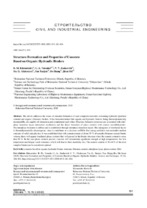| dc.contributor.author | Khroustalev, B. M. | |
| dc.contributor.author | Veranko, U. A. | |
| dc.contributor.author | Zankavich, V. V. | |
| dc.contributor.author | Aliakseyeu, Yu. G. | |
| dc.contributor.author | Yue, Xuejun | |
| dc.contributor.author | Shang, Bo | |
| dc.contributor.author | Jicun, Shi | |
| dc.coverage.spatial | Минск | ru |
| dc.date.accessioned | 2020-06-09T09:30:05Z | |
| dc.date.available | 2020-06-09T09:30:05Z | |
| dc.date.issued | 2020 | |
| dc.identifier.citation | Structure Formation and Properties of Concrete Based on Organic Hydraulic Binders = Процессы структурообразования и свойства бетонов на органогидравлических вяжущих / B. M. Khroustalev [et al.] // Наука и техника. – 2020. – № 3. – С. 181-194. | ru |
| dc.identifier.uri | https://rep.bntu.by/handle/data/73543 | |
| dc.description.abstract | The article addresses the issues of structure formation of road composite materials containing hydraulic (рortland cement) and organic (bitumen) binders. It has been determined that organic and hydraulic binders, being thermodynamically incompatible, are capable of interaction and complement each other. Structure formation processes are associated with interphase transition layers interaction mechanism and the direct formation of phase contacts with cement crystallohydrates. The interphase boundary is diffuse and is established through interphase transition layers. The emergence of interfacial layers is thermodynamically advantageous, since it contributes to a decrease in Gibbs free energy and does not contradict modern concepts of solid state physics. It was established that with cement content of about 30 % of complex bitumen-cement binder volume, there will appear (nucleate) phase contacts that will prevail in the binder structure when the cement content is more than 60 %. In the case phase contacts prevail, concrete will demonstrate significant strength at high temperatures, but low temperature and fatigue crack resistance, which will lead to their durability loss. The cement content of 30–40 % of the total complex binder can be considered optimal. | ru |
| dc.language.iso | en | ru |
| dc.publisher | БНТУ | ru |
| dc.title | Structure Formation and Properties of Concrete Based on Organic Hydraulic Binders | ru |
| dc.title.alternative | Процессы структурообразования и свойства бетонов на органогидравлических вяжущих | ru |
| dc.type | Article | ru |
| dc.identifier.doi | 10.21122/2227-1031-2020-19-3-181-194 | |
| local.description.annotation | Рассмотрены вопросы структурообразования дорожных композитных материалов, содержащих в своем составе гидравлические (портландцемент) и органические (битум) вяжущие. Установлено, что, являясь термодинамически несовместимыми, органические и гидравлические вяжущие способны к взаимодействию и дополняют друг друга. Процессы структурообразования связаны с механизмом взаимодействия межфазных переходных слоев и непосредственного образования фазовых контактов кристаллогидратами цемента. Исследования процессов срастания кристаллогидратов цемента через органические пленки, микроскопический и рентгеноструктурный анализ подтвердили данные результаты. Граница раздела фаз является размытой и осуществляется через межфазные переходные слои. Процесс появления межфазных слоев выгоден с термодинамической точки зрения, поскольку способствует уменьшению свободной энергии Гиббса и не противоречит современным представлениям физики твердого тела. При содержании цемента около 30 % от объема комплексного битумно-цементного вяжущего начнут появляться (зарождаться) фазовые контакты, которые будут преобладать в структуре вяжущего при содержании цемента более 60 % по объему. В случае преобладания фазовых контактов бетоны будут обладать значительной прочностью при высоких температурах, но низкой температурной и усталостной трещиностойкостью, что приведет к потере их долговечности. Оптимальным можно считать содержание цемента в количестве 30–40 % от общего объема комплексного вяжущего. | ru |

